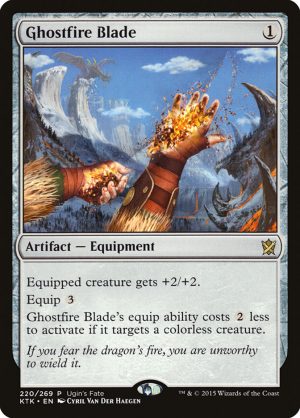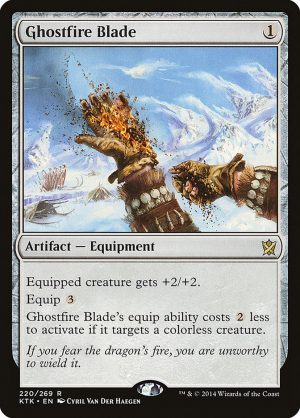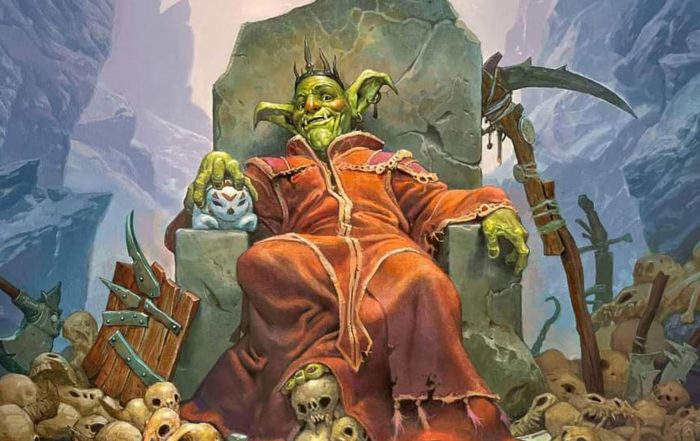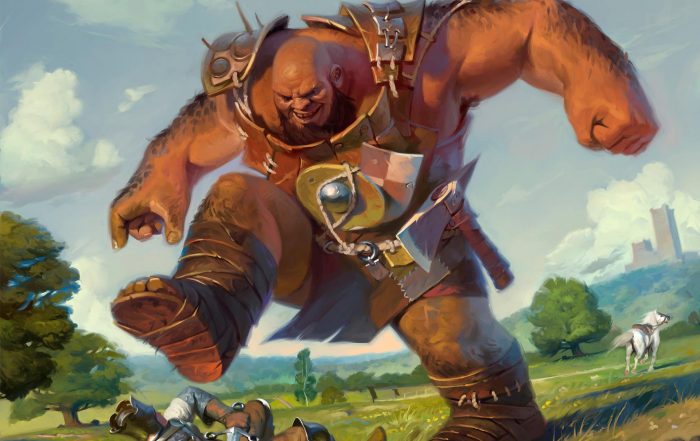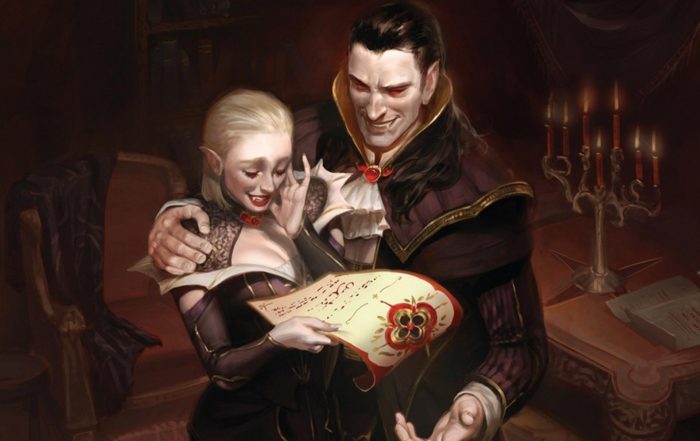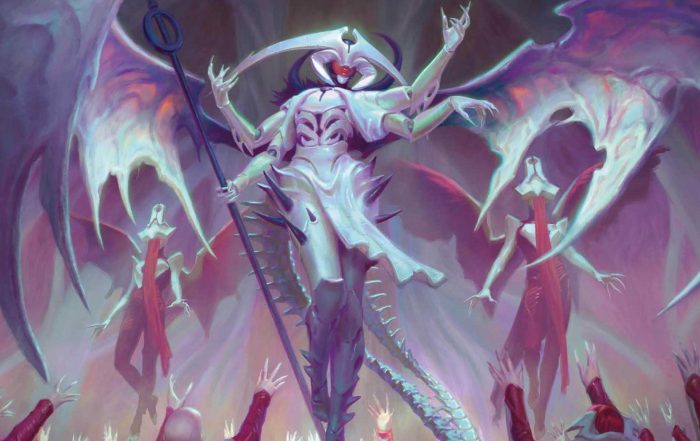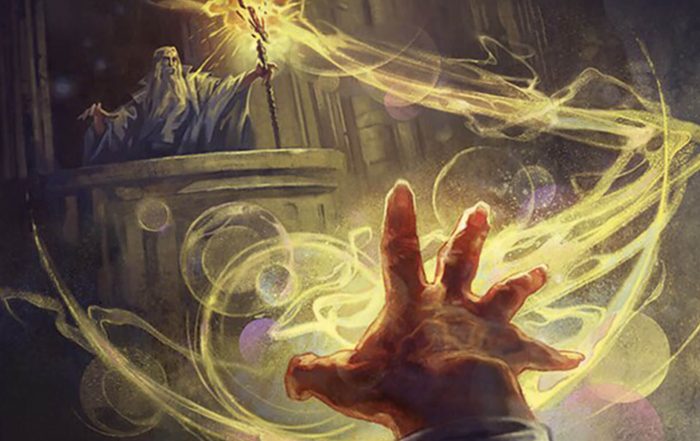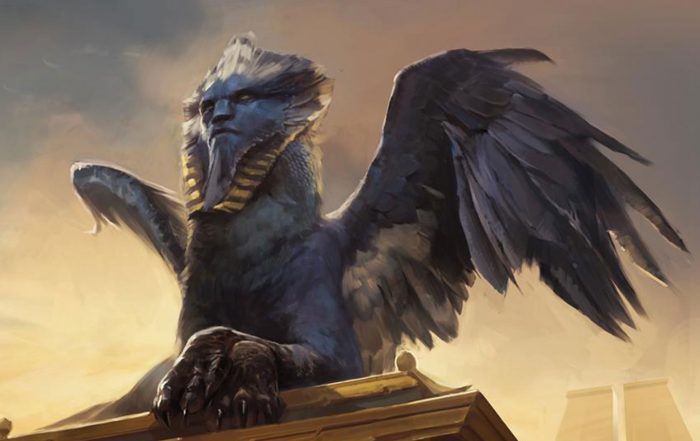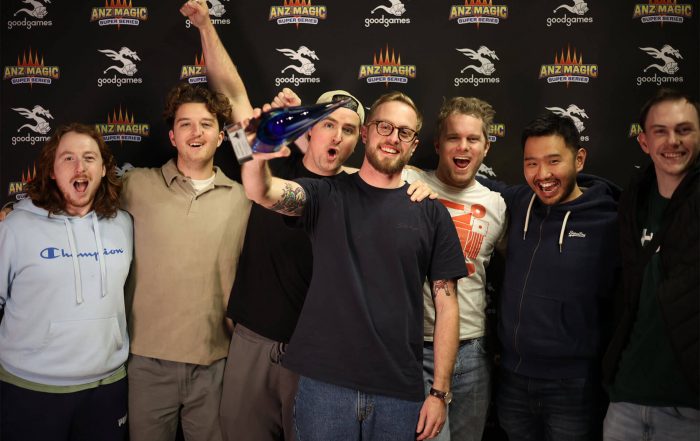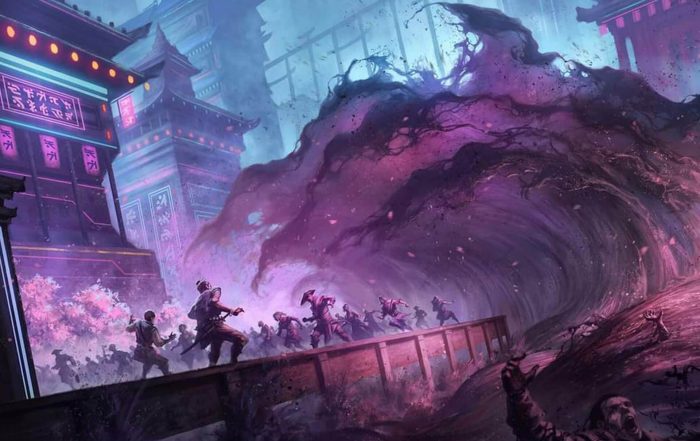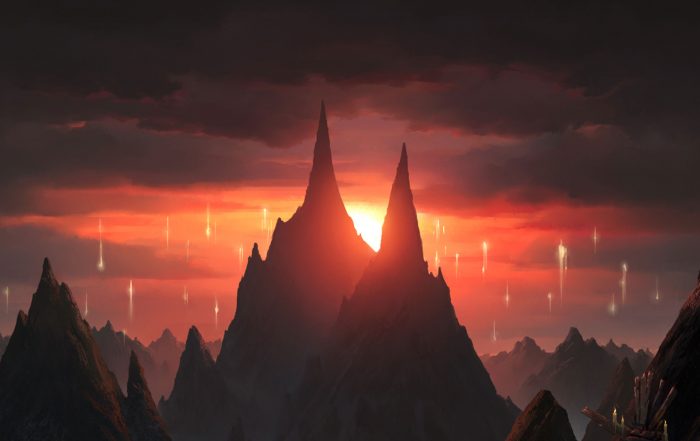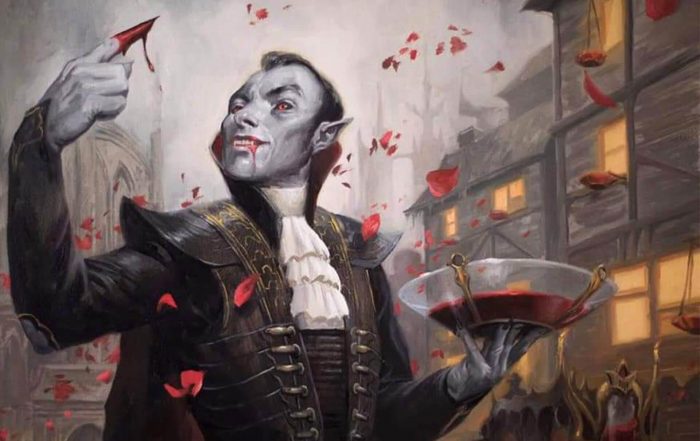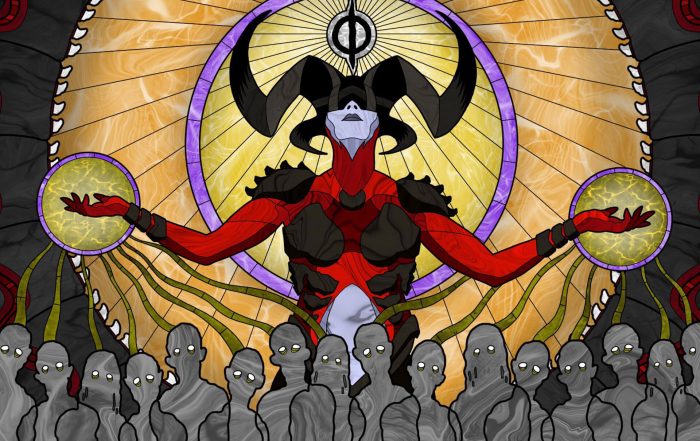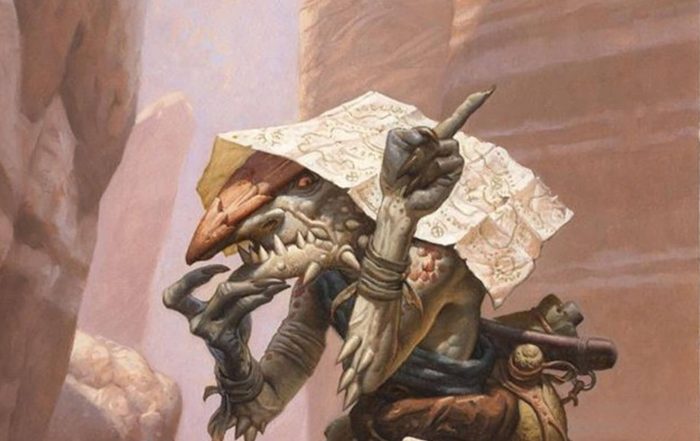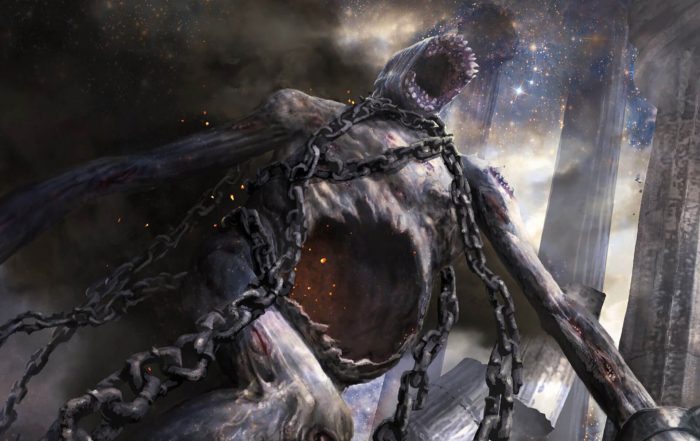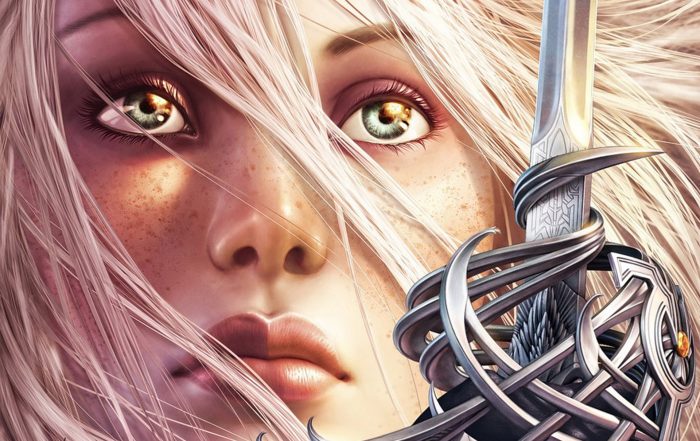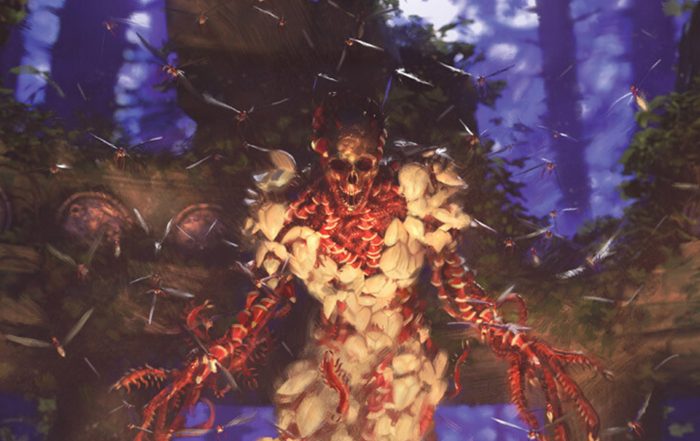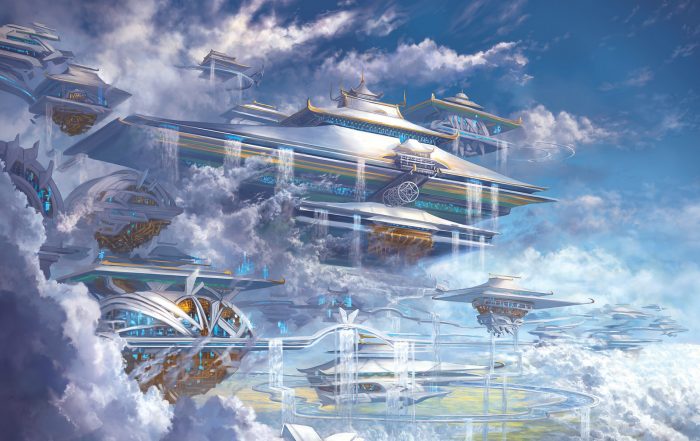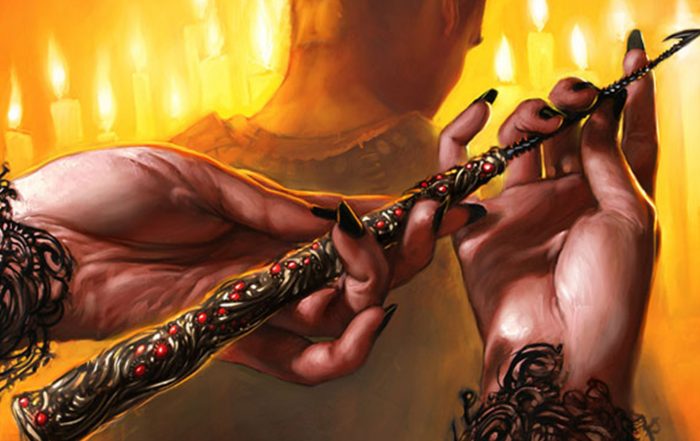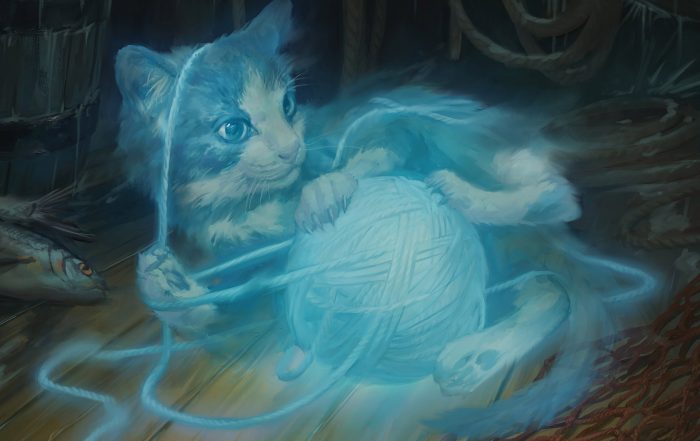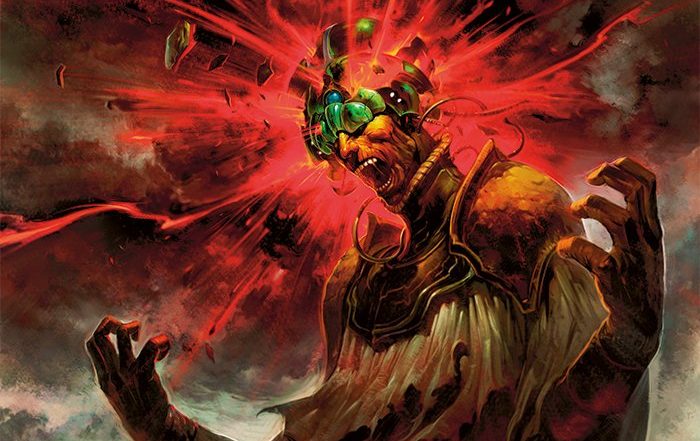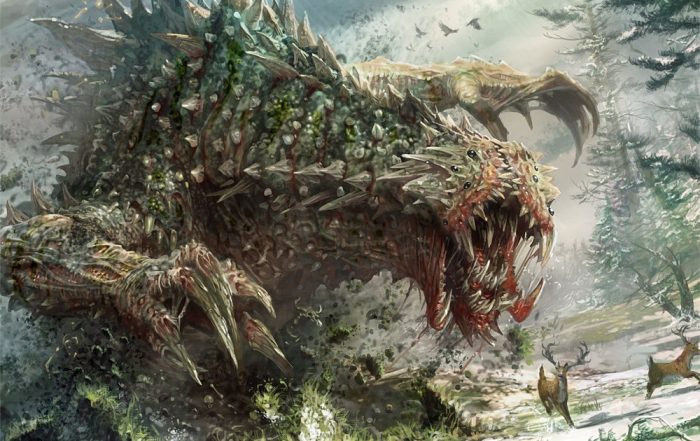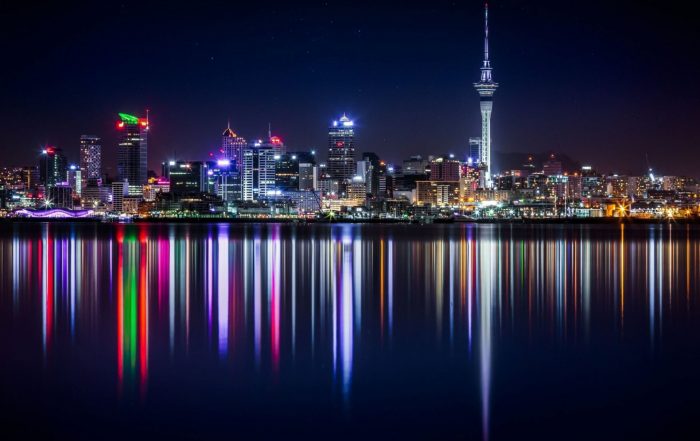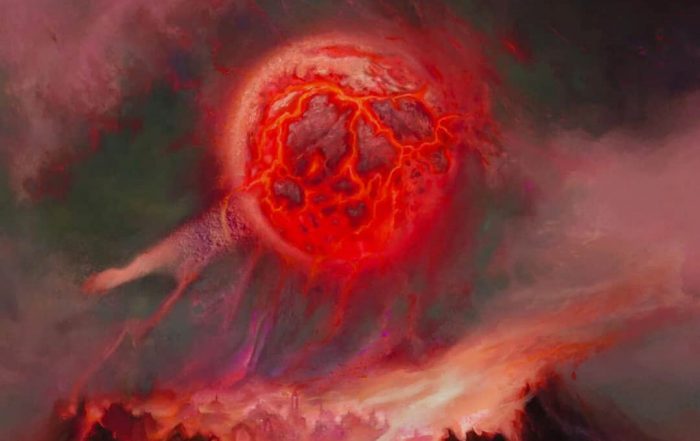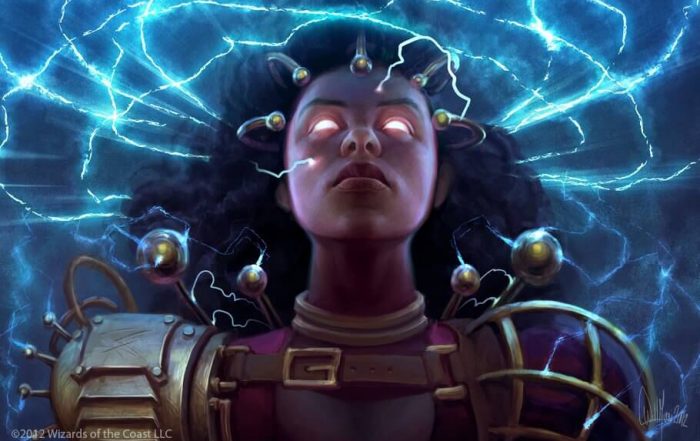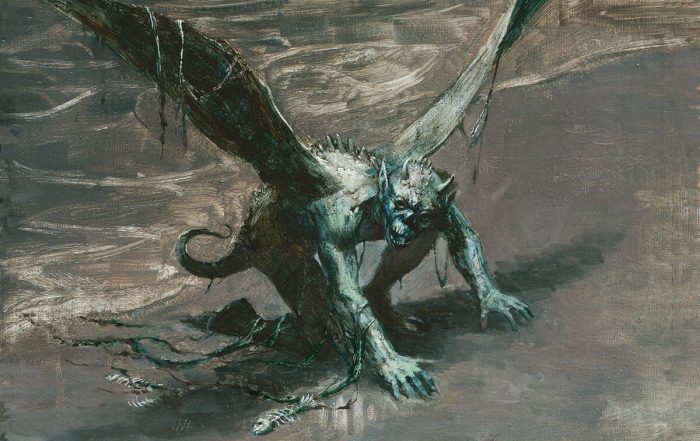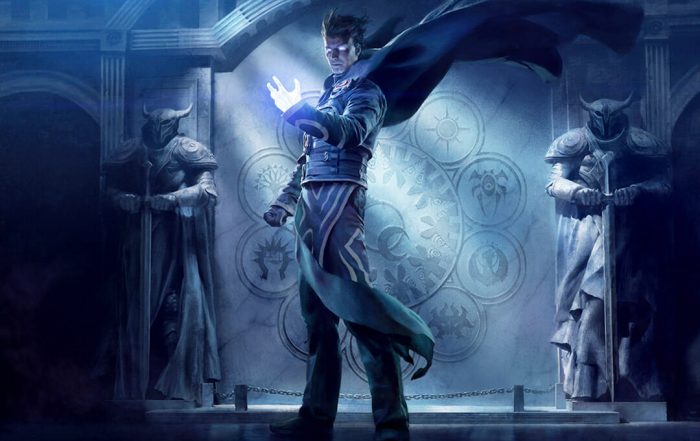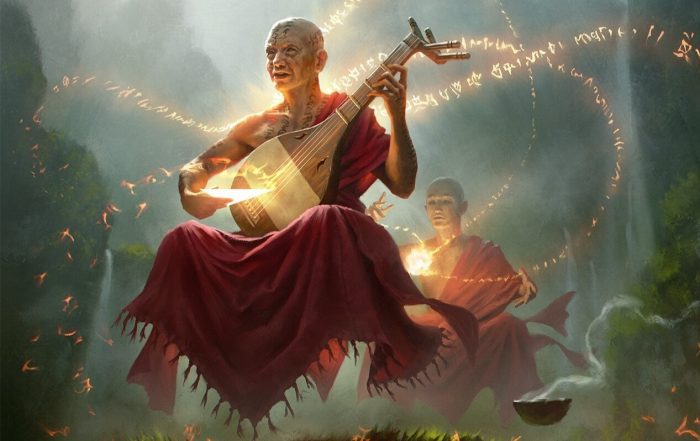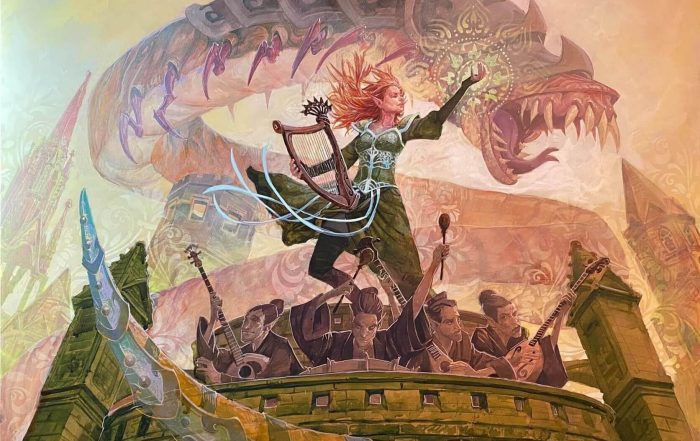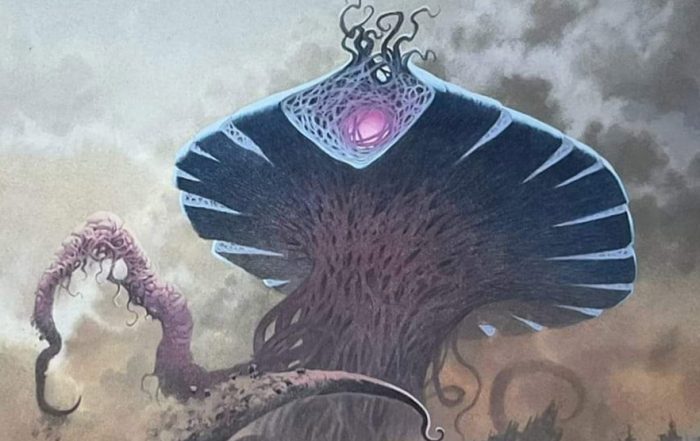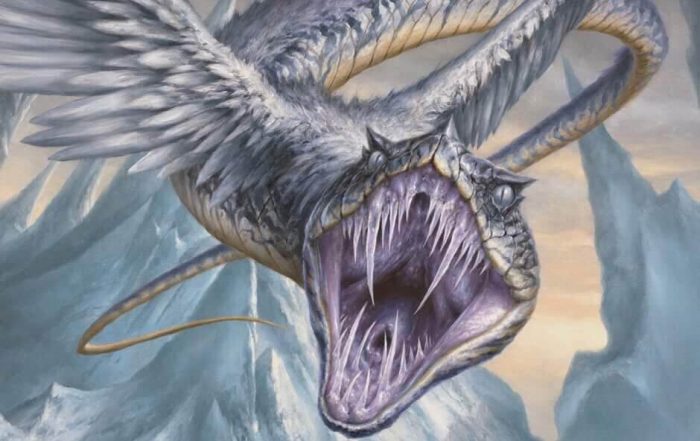Blue-Red Ensoul in Pioneer
How to crush Pioneer with Izzet Ensoul
Hello everybody!
With the Pro Tour Qualifier scene coming back after nearly three years off, I am very excited to try to get back onto the competitive circuit again! For the past few years, much of my Magic focus has been on Legacy, but with Pioneer being the key format for the first PTQ season, I decided it would be good to dip my toes back into one of Magic’s newer constructed formats.
My experience with Pioneer has been fairly limited, though funnily enough, it was also the format of the last major tournament I competed in. In January 2020, I played in Grand Prix Nagoya, which was the first Pioneer Grand Prix alongside the Grand Prix in Brussels that also ran on the same weekend. I played Mono Black Aggro deck, which was one of the more popular decks at the time, and ended up losing my win-and-in for Day Two. A few months later, in mid-2020, while we were locked down at home due to the pandemic, I picked up Pioneer again on Magic Online and decided to start playing Izzet Ensoul. At the time, I had a lot of success with the deck as it was one of the few decks that had a good Blue-Black Inverter matchup, and I ended up falling in love with the archetype as it’s the kind of strategy I love playing.
ORIGINAL DECKLIST
This was the decklist I was playing at the time:
Lands
Creatures
Spells
Sideboard
After the return of the Pro Tour and the inaugural Pioneer season was announced, I decided that this was the first deck I wanted to explore. A quick search on MTG Goldfish showed that the archetype hadn’t put up results on Magic Online in quite some time, but I also felt that the deck gained a few key cards in recent sets that people may have overlooked.
When I was playing this deck two years ago, there were two key issues in the main-deck. The first was the lack of good two-drop creatures. Most of the stock lists at the time played Steel Overseer, but I found the card to be simply too slow and susceptible to removal, so I switched to Scrapheap Scrounger, which obviously wasn’t great in a deck without black sources, but at least it could reliably attack on its own and could become a five-power threat with a Ghostfire Blade.
The second key issue was the two “flex” slots, where I played Emry, Lurker of the Loch. Simply put, the card just wasn’t very good. I did toy with a number of different cards in this slot, from Wild Slash to Stubborn Denial to Metallic Rebuke, but all of them were underwhelming and Emry was simply the least disappointing of the lot.
After I decided to explore the archetype again, my first course of action was to look up what were the new cards that had been printed since I last played the deck, as well as see what metagame developments there had been since then. The following was what I found:
White had gained a number of cards that would fit the archetype well. This included Ingenious Smith, Michiko’s Reign of Truth and Portable Hole. However, White’s key problem is the manabase. Blue-Red has access to four dual lands while Blue-White only has two – Hallowed Fountain and Hengegate Pathway. The deck’s manabase is not good because you don’t want to play more than twenty-one lands, and four of them need to be Darksteel Citadel. I think you could explore a Blue-White version of the deck by playing four Mana Confluence, but I decided to shelve the idea for now, especially as I wasn’t even convinced all these cards could make up for the loss of Shrapnel Blast and Red has access to better sideboard cards.
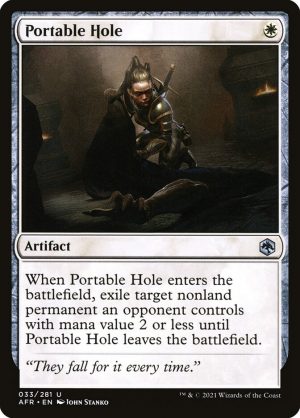
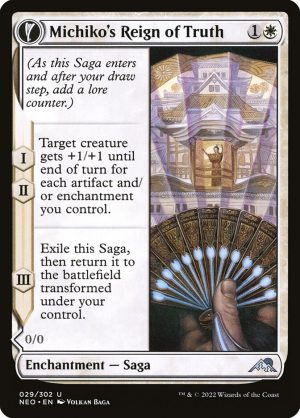
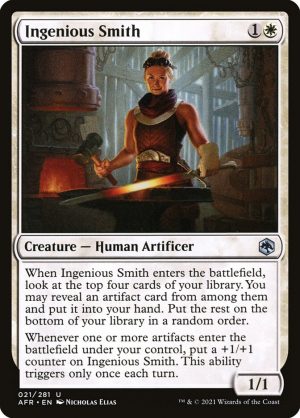 Blue-Black Inverter was no longer a deck since Inverter of Truth was banned, while 5c Niv-Mizzet and Bant Spirits were now a much smaller part of the metagame than it used to be. On the other hand, Naya Winota and Blue-Red Phoenix were two decks that were now a big part of the metagame, while Mono Red was more popular with the printing of Chandra, Dressed to Kill.
Blue-Black Inverter was no longer a deck since Inverter of Truth was banned, while 5c Niv-Mizzet and Bant Spirits were now a much smaller part of the metagame than it used to be. On the other hand, Naya Winota and Blue-Red Phoenix were two decks that were now a big part of the metagame, while Mono Red was more popular with the printing of Chandra, Dressed to Kill.
The deck gained a number of key cards. What stood out to me the most were the two good two-drops that were printed in the form of Patchwork Automaton and Lizard Blades, as well as the printing of The Blackstaff of Waterdeep, which could act as additional and more flexible, albeit weaker, copies of Ensoul Artifact. I also thought Mindlink Mech was an interesting card that could work in the deck – there are only so many three drops you can play and it was likely going to be worse than Skilled Animator, but it could be good if combined with Bomat Courier/Gingerbrute or the previously mentioned Lizard Blades.

In addition to Lizard Blades, there were a number of other red cards I liked. Voltage Surge was the most obvious one – it was just better than Wild Slash as the latter seldom went to the face, while having the option to kill Wionta, Joiner of Forces or Thing in the Ice was invaluable.
I also liked Burning Hands as a sideboard option for the Green Devotion matchup.
Current Decklist
Based on this, I put together an initial list, and played a bunch of games with a friend who had built up most of the top decks in the format. After running it through the gauntlet, the following was the list I came to:
Lands
Creatures
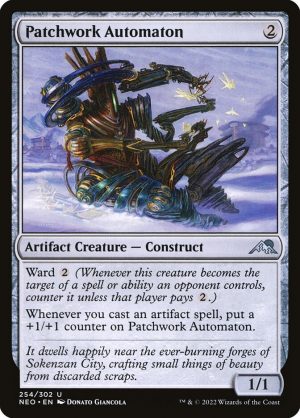
I wasn’t sure which two-drop was better between Patchwork Automaton and Lizard Blades, so I initially tried a split. I quickly found that the red creature was in fact much better in this deck.
The main problem with Patchwork Automaton was simply that this deck doesn’t actually trigger it all that often. You usually try to play out your artifact creatures on the first two turns, and then from turn three onwards you want to play cards like Ensoul Artifact and Skilled Animator to buff your creatures, but unfortunately these cards aren’t artifacts. On the other hand, Lizard Blades works incredibly well with these cards.
An Ensoul Artifact or Skilled Animator with the new two-drop is a ten-damage threat on turn three, and even with The Blackstaff of Waterdeep it’s an eight-damage threat. It also works well as an equipment, as you can give one of your existing five-power creatures double strike. It’s especially potent when combined with Ornithopter or Gingerbrute as they are evasive threats.
In the games I played, I commonly cast a Lizard Blades on turn four and equipped it to my five-power Ornithopter to fly over for ten damage. The only drawback of Lizard Blades is that it is not colorless, which means you cannot equip Ghostfire Blade to it for one mana.
I initially started with two copies of The Blackstaff of Waterdeep and I was quickly impressed. Like Ghostfire Blade, the card turns each of your creatures into a threat, as even if they kill your creature, you can buff a different creature. It’s also an artifact itself, so you can turn it into a creature with Ensoul Artifact or Skilled Animator. I would definitely play four copies if it wasn’t legendary, but as it is, I decided to stick with three. I was happy to cut a Skilled Animator for it, as the three-drop creature can often be clunky in multiples.
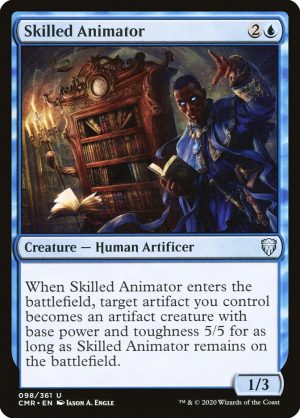
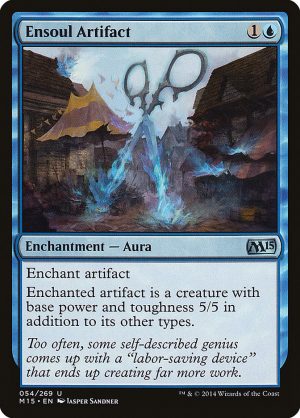 When I am figuring out my lands, I always refer to Frank Karsten’s guide to building manabases. In this deck, I reliably want access to both Red and Blue mana on turn two to cast Lizard Blades and Ensoul Artifact, which he recommends thirteen sources for. I decided to play an additional dual-land in the form of Riverglide Pathway, as I also wanted to be able to cast and activate The Blackstaff of Waterdeep on turn three, and cast The Royal Scions promptly in post-board games.
When I am figuring out my lands, I always refer to Frank Karsten’s guide to building manabases. In this deck, I reliably want access to both Red and Blue mana on turn two to cast Lizard Blades and Ensoul Artifact, which he recommends thirteen sources for. I decided to play an additional dual-land in the form of Riverglide Pathway, as I also wanted to be able to cast and activate The Blackstaff of Waterdeep on turn three, and cast The Royal Scions promptly in post-board games.
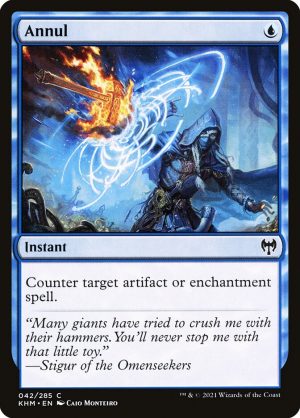
I made some changes to the sideboard from what I used to play. Wild Slash was replaced by Voltage Surge as it’s almost strictly better against creature decks since you don’t plan to target your opponent’s face and having the option to deal four is great. I also cut the Annuls, as they were primarily for the Mono White Devotion matchup but Walking Ballista has now been banned, and the Lava Coils, as Kalitas, Traitor of Ghet isn’t as popular as it used to be and there are more efficient removal options you can play. In their place, I’ve opted to play a split of Redcap Melee, Rending Volley and Burning Hands – each of them being an efficient piece of removal against specific creature decks. I prefer this to playing more generic removal spells, as this deck wants to be as mana efficient as possible.
Hands to Keep
Although this deck plays out quite differently to Dredge, the reason I took to this deck so quickly was that the process for keeping hands is similar to Dredge. The way to make mulligan decisions with this deck is to treat it as a combo deck without card manipulation. This means that you need to put together all the specific parts to “combo off”, but the lack of card manipulation means you need them present in your opening hand, as you can’t rely on finding them later.
This deck mulligans well as it can win with just a few cards. A turn two attacking Ensoul Artifact can often win games on its own, and if you can play two of your pay-off cards in the first three turns of the game, you are most likely winning.
On the other hand, if you don’t have the payoffs and/or aren’t attacking with five-power creatures, you are most likely going to lose as many cards in your deck are barely draft playable on their own. So you must be very disciplined with your mulligan decisions.
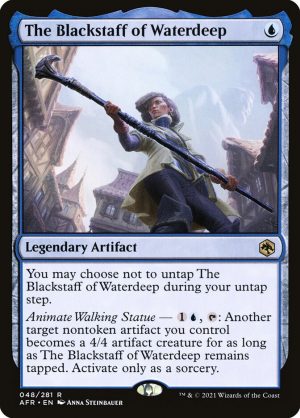
The general rule of thumb with seven or six card hands is to keep a hand with two or more enablers (Ensoul Artifact, Ghostfire Blade, The Blackstaff of Waterdeep, Shrapnel Blast and Skilled Animator), and ways to utilise them. This means do not keep a hand with two Ensoul Artifact, two Shrapnel Blast and three lands. Of the two or more enablers, you almost always want one to be an Ensoul Artifact or Ghostfire Blade, as that allows you to attack on turn two with a buffed creature (an alternative is a hand with Ornithopter and The Blackstaff of Waterdeep). A hand with double Skilled Animator is likely too slow as you won’t be attacking for five until turn three, while a hand with double Sharpnel Blast is unlikely to be good enough as your 1/1 creatures won’t be enough to deal the first ten damage you need to finish the game off with the burn spells.
You also want every seven or six card hand to have a one-drop creature. Although casting Stonecoil Serpent for one is not ideal, you need to start with a one drop-unless you have an Ornithopter or Ghostfire Blade you can Ensoul instead. The whole point of the deck is to m
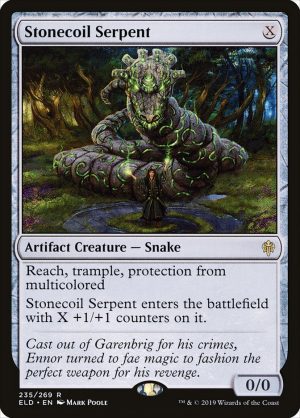
ake 5/5s (or 6/6s on a Stonecoil Serpent) ASAP, so anything will do.
I would aggressively mulligan any seven or six card hand that does not meet the above criteria. Once we reach the five card territory, I basically keep any hand, as four cards is simply too low. It may feel bad to mulligan so much, especially when you are forced to keep a bad five card hand but trust me, this deck is all about exploiting explosive draws. Your medium six card hand wouldn’t have won the game anyway, and the goal is to maximise your chanc of winning. It doesn’t matter how one sided your losses are as long as you’re increasing your odds of winning games.
Additional tips when playing the deck
Generally, casting Ensoul Artifact on an attacking creature on turn two is the best play you can make. However, against decks with a lot of removal like Blue-White Control, I will often opt for Ghostfire Blade instead – unless I have a hand that can already do four increments of five damage (like two Ensoul Artifact and two Shrapnel Blast in hand).
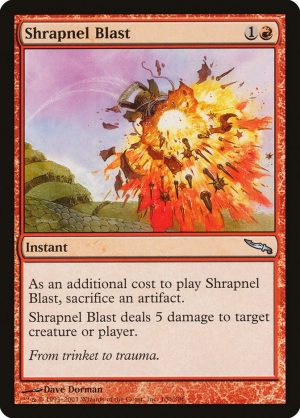
 Even against decks with many removal spells, if you have a chance to successfully land five damage with Ensoul Artifact/Skilled Animator, and have other ways to repeat that, I usually go for it. This deck does work in increments of five, and you usually only need to land about three hits in (you can chip away for the last few points of damage). It also forces your opponent to react to it as there’s now a threat that must be dealt with in play, and that can present another window to get in for five.
Even against decks with many removal spells, if you have a chance to successfully land five damage with Ensoul Artifact/Skilled Animator, and have other ways to repeat that, I usually go for it. This deck does work in increments of five, and you usually only need to land about three hits in (you can chip away for the last few points of damage). It also forces your opponent to react to it as there’s now a threat that must be dealt with in play, and that can present another window to get in for five.
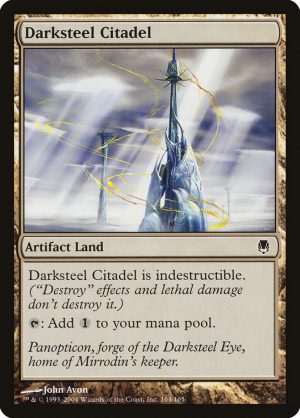
Against decks with Thoughtseize and Fatal Push, such as Black-Red Midrange and Mono Black Aggro, you want to set up Darksteel Citadel plus Ensoul Artifact as quickly as you can as they generally have no way to deal with it in pre-board games. Against Thoughtseize decks, on turn two if I have a Citadel I can enchant, I will always tap out to enchant my land in case they topdeck the discard spell.
Figuring out which artifact to enchant with Ensoul Artifact can be difficult. Against Black decks, as mentioned above, Darksteel Citadel is a good target. Against 5c Niv-Mizzet, Stonecoil Serpent is your best bet. Against ground-based decks, an evasive threat like Ornithopter or Gingerbrute is the way to go.
Remember that Stonecoil Serpent has reach. This matters as the Spirits matchup often comes down to a race, and chump-blocking with it can be crucial. People also often forget it has reach, and you might randomly ambush a Spell Queller with it.
Against decks with a lot of removal, you often attack with your creatures first, then cast Ensoul Artifact/Skilled Animator post-combat. This is to play around their removal spells – they may use it in combat, and even if they don’t, at least you got to get in for damage first.
Gingerbrute can chump block, and sacrifice itself to gain three life. Although this may seem like a minor detail, this comes up often in aggro mirrors where you’re both racing, and your opponent will often miss it.
Mutavault is colorless, so you can equip Ghostfire Blade to it for one mana.
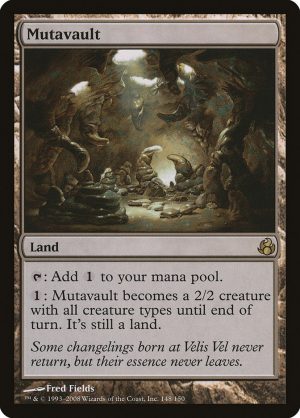
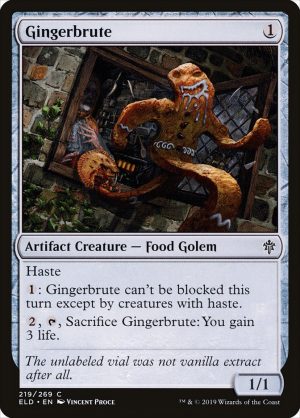
I hope you enjoyed this article, as I explored Pioneer for the first time in two years! To be totally honest, I haven’t enjoyed the gameplay of the format so far, as I feel that most decks are focused on executing their gameplan and often the games come down to who was on the play and the gameplay can feel like two ships passing in the night. It reminds me a lot of Modern in the early days of the format, where everyone was playing degenerate decks and trying to goldfish each other – only Pioneer is about two turns slower than that Modern format.
Regardless though, it is the format we will have to focus on over the next few months, and unless we see some major shakeups, we will need to get used to this kind of gameplay. I do appreciate that many of the decks are built upon Standard decks from days past, and so I am excited to revisit some of those archetypes again as I continue to delve into the format!
Till next time!
Zen Takahashi
@mtgzen on Twitter
About the Author
Zen Takahashi is a seasoned writer and mainstay on the Three for One Trading writing team. He is an avid Eternal player from Auckland, New Zealand and enjoys competing in local Legacy events and playing Old School over webcam with friends.
Previously, he was a Silver Pro for multiple years and his results included five Grand Prix Top 8s, a 27th place at Pro Tour Amonkhet, three consecutive online Regional PTQ wins, and he co-created the Modern Dredge deck.
Nowadays though, he primarily plays Legacy, his favorite format, but he also branches out into Pioneer and Modern.

More Articles by Zen Takahashi
AUS/NZ Regional Championship Report – Top 8
Zen qualified for the Pro Tour with Bant Toxic at the Australian/New Zealand Regional Championship! Now here’s all about his tournament experience, the preparation, the team and the many, many deck choices available.
Bant Toxic Guide
Learn all about Bant Toxic in Standard with Zen: The game plan, what hands to keep, how to sequence your turns, tips and tricks, and how to approach each of the major matchups.
Mono Red in Standard
The perfect preparation for our next Store Championship! Zen gives you all the information you need to win in Standard with Mono Red Aggro. As usual he gives you a small run down of the deck together with a lot of different sideboard guides against almost every meta deck of the format.
Rakdos Midrange in Pioneer [Update]
Mistakes have been made and lessons have been learned, so it’s time for an update on Zen’s Rakdos Midrange deck in Pioneer. This time with a very detailed matchup guide on the current Pioneer Meta with sideboard options for each popular deck you’ll encounter.
World Championships 2023 Report
Zen Takahashi is back with a full report of his time during the Magic: The Gathering World Championships 2023 in Las Vegas! Learn everything about his intense preparations, his great team, his tight schedule and tasty dinners.
Rakdos Reanimator Guide [2023]
Zen Takahashi played Rakdos Reanimator at the Magic: The Gathering World Championships in Las Vegas! In his latest article, he goes in-depth about how to play the deck, what to look out for in popular matchups and explains how to make best use of The Cruelty of Gix.
The Lord of the Rings Pro Tour Report
Zen Takahashi is back with another tournament report! This time it's all about Lord of the Rings in Barcelona. In this detailed article, he goes over his draft preparations and the overall fantastic weekend with his team and friends.
Modern Living End Primer
Zen Takahashi played Living End during the Lord of the Rings Pro Tour in Barcelona. Now he's ready to share some insights on this powerful Modern deck including the card choices, what hands to keep and how to sideboard against different opponents.
Regional Championship Report – Sydney
Zen Takahashi played Mono White Humans in Pioneer during the Regional Championships in Sydney! Find out all about what deck he played, what useful tips and tricks he had up his sleeves and how it all went down in his latest article! Bonus insider info on where to get the best truffle pasta in Sydney!
Pro Tour March of the Machine Tournament Report
Zen Takahashi writes about his experience during the Pro Tour in Minneapolis! Here you can read all about what deck he played, his preparation and a full report on the Pro Tour weekend with his team.
Rakdos in Standard
Our author Zen Takahashi competed at the Pro Tour in Minneapolis, shortly before re-qualifying for another Pro Tour. Both times he played Rakdos: Reanimator and Midrange! In his latest article, he compares both experiences and goes over each of the two decks in detail.
Standard Grixis Midrange Primer
Zen won the Australasian Championship with his Standard Grixis Midrange deck a few days ago. Lucky for us, he didn't take a break and wrote an in-depth primer for the deck including sideboard tips and card choices for us! Prepare yourself for future Regional Championships or Qualifiers, because you'll be either playing this deck or playing against it.
Australasian Regional Championships Report
Zen Takahashi won the Australasian Championship and qualified for the Pro Tour and the World Championship! Now we are getting an in-depth look into how he prepared for the tournament and how the games played out in an old-fashioned tournament report.
Boros Burn in Modern
Our author Zen Takahashi is feeling nostalgic, so it was time for a break from Pioneer and time for Modern Burn, Modern Boros Burn, to be precise! As usual Zen gives you a detailed overview of the deck, nice tips and tricks on how to maneuver it around the Modern meta decks and a useful sideboarding options, based on his experience.
Rakdos Midrange in Pioneer
Zen Takahashi is not done with Pioneer yet! For the Regional Championschip in Sydney, he and his team of over 10 other players tested different decks extensively until they came up with their own twist on the popular Rakdos Midrange deck.
Mono White Humans in Pioneer
Zen Takahashi takes a closer look at his newest favorite deck in Pioneer: Mono White Humans! As usual, you can expect in-depth tips and tricks as well as a sideboard guide from Zen, who was already very successful with his Pioneer decks in his Regional Championship Qualifiers.
Best Cards in Modern – Multicolor [2022]
We asked our seasoned team of authors a tough question: What do they think are the best ten multicolored cards in Magic the Gathering's Modern format. We then went a step further and created a Top 5. Learn what they think about the very best cards of one of the game's most popular formats.
Best Cards in Modern – Lands [2022]
We asked our seasoned team of authors a tough question: What do they think are the best ten lands in Magic the Gathering's Modern format. We then went a step further and created a Top 5. Learn what they think about the very best cards of one of the game's most popular formats.
Best Cards in Modern – Artifacts [2022]
We asked our seasoned team of authors a tough question: What do they think are the best ten artifacts in Magic the Gathering's Modern format. We then went a step further and created a Top 5. Learn what they think about the very best cards of one of the game's most popular formats.
Mono Red Primer for Pioneer
This time, Zen Takahashi writes in depth about his Regional Championship Qualifier Deck: Mono Red in Pioneer! That means we get a Primer for Mono Red Burn and Mono Red Frenzy. He also doesn't spare any details about key matchups in Pioneer and helps you to play your way around them!
Mono Blue Spirits in Pioneer
Zen Takahashi can't get enough of Pioneer, which means we have another great Pioneer Primer for you: Mono Blue Spirits! Read all about mulligans, sideboarding and most importantly: How to sequence your turns.
Best Cards in Modern – White [2022]
We asked our seasoned team of authors a tough question: What do they think are the best ten white cards in Magic the Gathering's Modern format. We then went a step further and created a Top 5. Learn what they think about the very best cards of one of the game's most popular formats.
How to Build Mono Red in Pioneer
After the success of his Blue-Red Ensoul article, Zen is back with another Pioneer primer: Mono Red! In his latest work, he excessively tested Devotion, Wizard and Burn decks. You can find all his discoveries and recommendations right here:
Legacy Reanimator 2022
If you are looking for a Reanimator Primer in Legacy, look no further! In his article, Zen Takahashi gives you everything you need to know about Reanimator: Which hands to keep? What are your opponents playing? How to sideboard? All these questions and more will be answered right here.
Blue-Red Ensoul in Pioneer
After a longer break, our author Zen Takahashi is excited to get back into Pioneer and crush the first PTQ season with his version of Izzet Ensoul. You can read all about the new and old decklist as well as mulligan strategies and other tips right here!
Best Cards in Modern – Green [2022]
We asked our seasoned team of authors a tough question: What do they think are the best ten green cards in Magic the Gathering's Modern format. We then went a step further and created a Top 5. Learn what they think about the very best cards of one of the game's most popular formats.
Auckland Eternal Weekend Report
Our author, Zen Takahashi, spent an Eternal Weekend in Auckland where he played tournaments of Vintage, Old School and Legacy. Real Power Nine, no proxies allowed! You can read all about what decks he played and how it went right here on our blog!
Best Cards in Modern – Red [2022]
We asked our seasoned team of authors a tough question: What do they think are the best ten red cards in Magic the Gathering's Modern format. We then went a step further and created a Top 5. Learn what they think about the very best cards of one of the game's most popular formats.
Top Ten Decks in Legacy 2022
In our latest article, Zen Takahashi analyses the best Legacy decks and comes up with his Top 10 Legacy decks of 2022. If you are curious to find out if your deck made the cut, or simply interested in what's going on in Legacy these days, keep on reading right here!
Best Cards in Modern – Black [2022]
We asked our seasoned team of authors a tough question: What do they think are the best ten black cards in Magic the Gathering's Modern format. We then went a step further and created a top 5. Learn what they think about the very best cards of one of the game's most popular formats.
Rainbow Dredge in Modern
Today’s article is all about Dredge in Magic: The Gathering, more specifically, Dredge in Modern. Zen Takahashi, one of the creators of Rainbow Dredge, took a look at the history of the deck and its current state in the meta. He’s also going over different iterations of the deck, as well as all the current sideboard options available.
Best Cards in Modern – Blue [2022]
We asked our seasoned team of authors a tough question: What do they think are the best ten blue cards in Magic the Gathering's Modern format. We then went a step further and created a top 5. Learn what they think about the very best cards of one of the game's most popular formats.
Blue Zenith in Legacy
Zen takes a look at a new deck that did surprisingly well in recent Legacy online events. Green Sun's Zenith and blue Counterspells are the engine in this midrange powerhouse.
Deck Spotlight Modern: Golgari Yawgmoth
Zen takes us to a wonderful world full of creatures, combos and one ofs in the Magic the Gathering Modern format. Chord of Calling is the name of the game. Let's go!
Deck Spotlight Legacy: UW Omni-Tell
Zen talks about one of his favorite decks for paper Legacy: Blue-White Show and Tell Omniscience combo. The best thing about it: It does not need a single card from the restriced list!
Bant Miracles in Post-Modern Horizons 2 Legacy
Zen Takahashi shares his thoughts about his favorite Legacy Deck – Bant Miracles in a Post-Modern Horizons 2 world. He explains which cards he added from the new set and how matchups have changed.
